A Study of the Relationship between the Dynamic Viscosity and Thermodynamic Properties of Palm Oil, Hydrogenated Palm Oil, Paraffin, and Their Mixtures Enhanced with Copper and Iron Fines
Abstract
:1. Introduction
2. Materials and Methods
2.1. Characteristics of the Tested Substances
2.1.1. Palm Oil
2.1.2. Hydrogenated Palm Oil
2.1.3. Soft Paraffin
2.1.4. Added Substances
2.1.5. Copper
2.1.6. Iron Fines
2.2. Testing Station
2.3. Preparation of the Stand and Samples for Testing
2.3.1. Sample Preparation
2.3.2. Test Stand Configuration
2.3.3. Temperature Measurement and Phase Transformation Curve
2.4. Viscosity Measurement
2.5. Statistical Tools
2.6. Calculation Algorithm Used in the Analysis
2.6.1. Algorithm for Calculating Specific Heat Capacity
- —heat the beaker [J];
- —mass of the glass [kg];
- —specific heat capacity of the glass ;
- —temperature change [°C].
- —heat flux generated by power supplies and cell [W];
- —heating time of the substance [s];
- —voltage [A];
- —current intensity [V];
- —heat flux of the Peltier module [W].
- —specific heat for the solid state of the PCM ;
- —heat of the PCM [J];
- —heat generated by heating the system [J];
- —mass of the substance [kg];
- —temperature change [°C];
- —heat the beaker [J].
2.6.2. Algorithm for Calculating Fusion Heat Capacity
3. Results and Discussion
3.1. Eutectics of the Tested Substances
- For the substance containing 100% palm oil, the transformation temperature was 35 °C;
- For the system with a concentration of 75% palm oil and 25% hydrogenated palm oil, the transformation temperature was 39–40 °C;
- For the system with a concentration of 50% palm oil and 50% hydrogenated palm oil, the transformation temperature was 40–44 °C;
- For the system with a concentration of 25% palm oil and 75% hydrogenated palm oil, the transformation temperature was 42–45 °C;
3.2. Viscosity Measurement
- Soft paraffin has a relatively low average viscosity of 27.86 mPa·s compared with the other substances on the chart. This is beneficial in terms of the fluidity and movement of the substance;
- Palm oil has a higher average viscosity of 45.94 mPa·s than soft paraffin. This means it may be less liquid and thicker;
- Hydrogenated palm oil has an even higher viscosity of 54.24 mPa·s than palm oil. It is a substance with a higher density and less liquid;
- The mixture of 50% palm oil and 50% soft paraffin appears to have an average viscosity of 32.56 mPa·s between pure palm oil and soft paraffin;
- The mixture of 50% hydrogenated palm oil and 50% palm oil appears to have an average viscosity of 52.28 mPa·s, similar to hydrogenated palm oil alone;
- The mixture of hydrogenated palm oil (33%), palm oil (33%), and soft paraffin (33%) appears to have a moderate viscosity of 38 mPa·s;
- Another blend, hydrogenated palm oil (20%) + palm oil (30%) + soft paraffin (50%), appears to have a moderately low viscosity of 32.06, perhaps dominated by soft paraffin.
- Soft paraffin appears to have a moderate viscosity of 27.86 mPa·s and a higher melting point of 49.5 °C;
- Palm oil has a relatively high viscosity of 45.94 mPa·s and a lower melting point of 35 °C;
- Hydrogenated palm oil is characterized by a high viscosity of 54.24 mPa·s and a moderately high melting point of 50 °C;
- The mixture of 50% palm oil and 50% soft paraffin appears to have a moderate viscosity of 32.56 and a moderately high melting point of 45 °C;
- A blend of 50% hydrogenated palm oil and 50% palm oil appears to have a high viscosity of 52.28 and a moderately low melting point of 42 °C;
- The mixture containing the three ingredients—hydrogenated palm oil (33%), palm oil (33%), and soft paraffin (33%)—has a moderate viscosity of 38 mPa·s and a melting point of 38.5 °C;
- Another blend—hydrogenated palm oil (20%) + palm oil (30%) + soft paraffin (50%)—appears to have a moderately low viscosity of 32.06 mPa·s and a moderately high melting point of 40 °C.
3.3. Statistical Analysis
3.4. Comparison of Tested Substances
3.5. Experimental Determination of Parameters
4. Conclusions
Author Contributions
Funding
Institutional Review Board Statement
Informed Consent Statement
Data Availability Statement
Acknowledgments
Conflicts of Interest
References
- Manasijević, I.; Balanovic, L.; Holjevac Grgurić, T.; Minić, D.; Gorgievski, M. Study of Microstructure and Thermal Properties of the Low Melting Bi-In-Sn Eutectic Alloys. Mater. Res. 2018, 21, e20180501. [Google Scholar] [CrossRef]
- Singh, S.B.; De, M. Alumina Based Doped Templated Carbons: A Comparative Study with Zeolite and Silica Gel Templates. Microporous Mesoporous Mater. 2018, 257, 241–252. [Google Scholar] [CrossRef]
- Deka, P.; Szlęk, A. Thermal Energy Storage in Buildings: Opportunities and Challenges. Arch. Thermodyn. 2022, 43, 21–61. [Google Scholar] [CrossRef]
- Singh, P.; Sharma, R.; Ansu, A.; Goyal, R.; Sarı, A.; Tyagi, V. A Comprehensive Review on Development of Eutectic Organic Phase Change Materials and Their Composites for Low and Medium Range Thermal Energy Storage Applications. Sol. Energy Mater. Sol. Cells 2021, 223, 110955. [Google Scholar] [CrossRef]
- Masood, U.; Haggag, M.; Hassan, A.; Laghari, M. A Review of Phase Change Materials as a Heat Storage Medium for Cooling Applications in the Built Environment. Energy Build. 2023, 13, 1595. [Google Scholar] [CrossRef]
- Rathore, P.K.S.; Shukla, S.K. Enhanced Thermophysical Properties of Organic PCM through Shape Stabilization for Thermal Energy Storage in Buildings: A State of the Art Review. Energy Build. 2021, 236, 110799. [Google Scholar] [CrossRef]
- Kahwaji, S.; White, M.A. Organic Phase Change Materials for Thermal Energy Storage: Influence of Molecular Structure on Properties. Molecules 2021, 26, 6635. [Google Scholar] [CrossRef] [PubMed]
- Ushak, S.; Gutierrez, A.; Galleguillos, H.; Fernandez, A.G.; Cabeza, L.F.; Grágeda, M. Thermophysical Characterization of a By-Product from the Non-Metallic Industry as Inorganic PCM. Sol. Energy Mater. Sol. Cells 2015, 132, 385–391. [Google Scholar] [CrossRef]
- Nartowska, E.; Styś-Maniara, M.; Kozłowski, T. The Potential Environmental and Social Influence of the Inorganic Salt Hydrates Used as a Phase Change Material for Thermal Energy Storage in Solar Installations. Int. J. Environ. Res. Public Health 2023, 20, 1331. [Google Scholar] [CrossRef] [PubMed]
- Farid, M.M.; Khudhair, A.M.; Razack, S.A.K.; Al-Hallaj, S. A Review on Phase Change Energy Storage: Materials and Applications. Energy Convers. Manag. 2004, 45, 1597–1615. [Google Scholar] [CrossRef]
- Hussain, S.I.; Dinesh, R.; Roseline, A.A.; Dhivya, S.; Kalaiselvam, S. Enhanced Thermal Performance and Study the Influence of Sub Cooling on Activated Carbon Dispersed Eutectic PCM for Cold Storage Applications. Energy Build. 2017, 143, 17–24. [Google Scholar] [CrossRef]
- Wang, Z.; Huang, G.; Jia, Z.; Gao, Q.; Li, Y.; Gu, Z. Eutectic Fatty Acids Phase Change Materials Improved with Expanded Graphite. Materials 2022, 15, 6856. [Google Scholar] [CrossRef]
- Qiao, G.; Zhou, Y.; Trendewicz, A.; He, Z.; Lei, X. Low-Temperature Phase Change Materials (PCM) for Integration with Sustainable Heating and Cooling Systems for Buildings. In Proceedings of the 2018 International Conference on Power System Technology (POWERCON), Guangzhou, China, 6–8 November 2018; pp. 4533–4536. [Google Scholar] [CrossRef]
- Tyagi, V.V.; Buddhi, D. PCM Thermal Storage in Buildings: A State of Art. Renew. Sustain. Energy Rev. 2007, 11, 1146–1166. [Google Scholar] [CrossRef]
- Bałon, P.; Kiełbasa, B.; Kowalski, Ł.; Smusz, R. Thermal Performance of the Thermal Storage Energy with Phase Change Material. Acta Mech. Autom. 2023, 17, 76–84. [Google Scholar] [CrossRef]
- Xu, C.; Zhang, H.; Fang, G. Review on Thermal Conductivity Improvement of Phase Change Materials with Enhanced Additives for Thermal Energy Storage. J. Energy Storage 2022, 51, 104568. [Google Scholar] [CrossRef]
- Wu, S.; Li, T.; Wu, M.; Xu, J.; Hu, Y.; Chao, J.; Yan, T.; Wang, R. Highly Thermally Conductive and Flexible Phase Change Composites Enabled by Polymer/Graphite Nanoplatelet-Based Dual Networks for Efficient Thermal Management. J. Mater. Chem. A 2020, 8, 20011–20020. [Google Scholar] [CrossRef]
- Agyenim, F.; Hewitt, N.; Eames, P.; Smyth, M. A Review of Materials, Heat Transfer and Phase Change Problem Formulation for Latent Heat Thermal Energy Storage Systems (LHTESS). Renew. Sustain. Energy Rev. 2010, 14, 615–628. [Google Scholar] [CrossRef]
- Lin, Y.; Jia, Y.; Alva, G.; Fang, G. Review on Thermal Conductivity Enhancement, Thermal Properties and Applications of Phase Change Materials in Thermal Energy Storage. Renew. Sustain. Energy Rev. 2018, 82, 2730–2742. [Google Scholar] [CrossRef]
- Renteria, J.D.; Nika, D.L.; Balandin, A.A. Graphene Thermal Properties: Applications in Thermal Management and Energy Storage. Appl. Sci. 2014, 4, 525–547. [Google Scholar] [CrossRef]
- Singh, R.; Sadeghi, S.; Shabani, B. Thermal Conductivity Enhancement of Phase Change Materials for Low-Temperature Thermal Energy Storage Applications. Energies 2018, 12, 75. [Google Scholar] [CrossRef]
- Zhang, P.; Ma, Z.W.; Wang, R.Z. An Overview of Phase Change Material Slurries: MPCS and CHS. Renew. Sustain. Energy Rev. 2010, 14, 598–614. [Google Scholar] [CrossRef]
- James, B.; Delaney, P. Phase Change Materials: Are They Part of Our Energy Efficient Future? In Proceedings of the ACEEE Summer Study on Energy Efficiency in Buildings, Pacific Grove, CA, USA, 12–17 August 2012; pp. 160–172. [Google Scholar]
- Delgado, M.; Lázaro, A.; Mazo, J.; Zalba, B. Review on Phase Change Material Emulsions and Microencapsulated Phase Change Material Slurries: Materials, Heat Transfer Studies and Applications. Renew. Sustain. Energy Rev. 2012, 16, 253–273. [Google Scholar] [CrossRef]
- Dutkowski, K.; Fiuk, J.J. Experimental Research of Viscosity of Microencapsulated PCM Slurry at the Phase Change Temperature. Int. J. Heat Mass Transf. 2019, 134, 1209–1217. [Google Scholar] [CrossRef]
- Diani, A.; Rossetto, L. Melting of PCMs Embedded in Copper Foams: An Experimental Study. Materials 2021, 14, 1195. [Google Scholar] [CrossRef] [PubMed]
- Martínez, A.; Carmona, M.; Cortés, C.; Arauzo, I. Characterization of Thermophysical Properties of Phase Change Materials Using Unconventional Experimental Technologies. Energies 2020, 13, 4687. [Google Scholar] [CrossRef]
- Weigand, R.; Hess, K.; Fleischer, A.S. Experimental Analysis of the Impact of Nanoinclusions and Surfactants on the Viscosity of Paraffin-Based Energy Storage Materials. J. Heat Transf. 2018, 140, 114502. [Google Scholar] [CrossRef]
- Belessiotis, V.; Kalogirou, S.; Delyannis, E. Water, the Raw Material for Desalination. In Thermal Solar Desalination: Methods and Systems; Elsevier Science: Amsterdam, The Netherlands, 2016; pp. 21–102. ISBN 978-0-12-809656-7. [Google Scholar]
- Jurkowska, M.; Szczygieł, I. Review on Properties of Microencapsulated Phase Change Materials Slurries (mPCMS). Appl. Therm. Eng. 2016, 98, 365–373. [Google Scholar] [CrossRef]
- Bains, U.; Pal, R. In-Situ Continuous Monitoring of the Viscosity of Surfactant-Stabilized and Nanoparticles-Stabilized Pickering Emulsions. Appl. Sci. 2019, 9, 4044. [Google Scholar] [CrossRef]
- Barreneche, C.; Ferrer, G.; Palacios, A.; Solé, A.; Fernández, A.I.; Cabeza, L.F. Empirical Equations for Viscosity and Specific Heat Capacity Determination of Paraffin PCM and Fatty Acid PCM. IOP Conf. Ser. Mater. Sci. Eng. 2017, 251, 012114. [Google Scholar] [CrossRef]
- Fabiani, C.; Pisello, A.L.; Barbanera, M.; Cabeza, L.F. Palm Oil-Based Bio-PCM for Energy Efficient Building Applications: Multipurpose Thermal Investigation and Life Cycle Assessment. J. Energy Storage 2020, 28, 101129. [Google Scholar] [CrossRef]
- Gesteiro, E.; Guijarro, L.; Sánchez-Muniz, F.J.; Vidal-Carou, M.d.C.; Troncoso, A.; Venanci, L.; Jimeno, V.; Quilez, J.; Anadón, A.; González-Gross, M. Palm Oil on the Edge. Nutrients 2019, 11, 2008. [Google Scholar] [CrossRef] [PubMed]
- Molefi, J.; Luyt, A.; Krupa, I. Comparison of LDPE, LLDPE and HDPE as Matrices for Phase Change Materials Based on a Soft Fischer–Tropsch Paraffin Wax. Thermochim. Acta 2010, 500, 88–92. [Google Scholar] [CrossRef]
- Almousa, N.H.; Alotaibi, M.R.; Alsohybani, M.; Radziszewski, D.; AlNoman, S.M.; Alotaibi, B.M.; Khayyat, M.M. Paraffin Wax [As a Phase Changing Material (PCM)] Based Composites Containing Multi-Walled Carbon Nanotubes for Thermal Energy Storage (TES) Development. Crystals 2021, 11, 951. [Google Scholar] [CrossRef]
- Arce, M.E.; Alvarez Feijoo, M.A.; Suarez Garcia, A.; Luhrs, C.C. Novel Formulations of Phase Change Materials—Epoxy Composites for Thermal Energy Storage. Materials 2018, 11, 195. [Google Scholar] [CrossRef]
- Muñoz-García, M.A.; Moreda, G.P.; Raga-Arroyo, M.P.; Marín-González, O. Water Harvesting for Young Trees Using Peltier Modules Powered by Photovoltaic Solar Energy. Comput. Electron. Agric. 2013, 93, 60–67. [Google Scholar] [CrossRef]
- Mazhar, A.R.; Ubaid, A.; Shah, S.M.H.; Masood, S.; Alvi, M.Z. Investigation of the Simultaneous Cooling and Heating Using a Thermoelectric Peltier. Eng. Proc. 2023, 45, 13. [Google Scholar] [CrossRef]
- Oyedeji, F.; Okeke, I. Comparative Analysis of Moisturizing Creams from Vegetable Oils and Paraffin Oil. Res. J. Appl. Sci. 2010, 5, 157–160. [Google Scholar]
- Melcer, A.; Klugmann-Radziemska, E.; Lewandowski, W. Phase Change Materials. Properties, Classification, Advantages and Disadvantages. Przem. Chem. 2012, 91, 1335–1346. [Google Scholar]
- Janarthanan, B.; Sagadevan, S. Thermal Energy Storage Using Phase Change Materials and Their Applications: A Review. Int. J. ChemTech Res. 2015, 8, 250–256. [Google Scholar]
- Ma, B.; Zhou, X.; Liu, J.; You, Z.; Wei, K.; Huang, X. Determination of Specific Heat Capacity on Composite Shape-Stabilized Phase Change Materials and Asphalt Mixtures by Heat Exchange System. Materials 2016, 9, 389. [Google Scholar] [CrossRef] [PubMed]
- Pan, J.; Zou, R.; Jin, F. Experimental Study on Specific Heat of Concrete at High Temperatures and Its Influence on Thermal Energy Storage. Energies 2016, 10, 33. [Google Scholar] [CrossRef]
- Pakalka, S.; Valančius, K.; Streckienė, G. Experimental and Theoretical Investigation of the Natural Convection Heat Transfer Coefficient in Phase Change Material (PCM) Based Fin-and-Tube Heat Exchanger. Energies 2021, 14, 716. [Google Scholar] [CrossRef]
- Williams, J.D.; Peterson, G.P. A Review of Thermal Property Enhancements of Low-Temperature Nano-Enhanced Phase Change Materials. Nanomaterials 2021, 11, 2578. [Google Scholar] [CrossRef] [PubMed]
- Barz, T.; Sommer, A. Modeling Hysteresis in the Phase Transition of Industrial-Grade Solid/Liquid PCM for Thermal Energy Storages. Int. J. Heat Mass Transf. 2018, 127, 701–713. [Google Scholar] [CrossRef]
- Hu, Y.; Guo, R.; Heiselberg, P.K.; Johra, H. Modeling PCM Phase Change Temperature and Hysteresis in Ventilation Cooling and Heating Applications. Energies 2020, 13, 6455. [Google Scholar] [CrossRef]
- Fuentes-Sepúlveda, R.; García-Herrera, C.; Vasco, D.A.; Salinas-Lira, C.; Ananías, R.A. Thermal Characterization of Pinus Radiata Wood Vacuum-Impregnated with Octadecane. Energies 2020, 13, 942. [Google Scholar] [CrossRef]
- Li, M.; Cao, Q.; Pan, H.; Wang, X.; Lin, Z. Effect of Melting Point on Thermodynamics of Thin PCM Reinforced Residential Frame Walls in Different Climate Zones. Appl. Therm. Eng. 2021, 188, 116615. [Google Scholar] [CrossRef]
- Liu, H.; Chen, C.; Li, Y.; Duan, Z.; Li, Y. Characteristic and Correlation Analysis of Metro Loads. In Smart Metro Station Systems; Elsevier Science: Amsterdam, The Netherlands, 2022; pp. 237–267. ISBN 978-0-323-90588-6. [Google Scholar]
- Xu, T.; Li, Y.; Chen, J.; Liu, J. Preparation and Thermal Energy Storage Properties of LiNO3-KCl-NaNO3/Expanded Graphite Composite Phase Change Material. Sol. Energy Mater. Sol. Cells 2017, 169, 215–221. [Google Scholar] [CrossRef]
- Liu, H.; Awbi, H.B. Performance of Phase Change Material Boards under Natural Convection. Build. Environ. 2009, 44, 1788–1793. [Google Scholar] [CrossRef]
- Salih, S.; Najim, S.; Jalil, J. Numerical Modeling for Novel Solar Air Heater Utilizing Wax Paraffin-PCM. Basrah J. Eng. Sci. 2019, 19, 1–8. [Google Scholar] [CrossRef]
- Wuliu, Y.; Liu, J.; Zhang, L.; Wang, S.; Liu, Y.; Feng, J.; Liu, X. Design of Bio-Based Organic Phase Change Materials Containing a “Safety Valve”. Green Chem. 2021, 23, 8643–8656. [Google Scholar] [CrossRef]
- Cui, Y.; Xie, J.; Liu, J.; Wang, J.; Chen, S. A Review on Phase Change Material Application in Building. Adv. Mech. Eng. 2017, 9, 1687814017700828. [Google Scholar] [CrossRef]
- Ndukwu, M.C.; Onyenwigwe, D.; Abam, F.I.; Eke, A.B.; Dirioha, C. Development of a Low-Cost Wind-Powered Active Solar Dryer Integrated with Glycerol as Thermal Storage. Renew. Energ. 2020, 154, 553–568. [Google Scholar] [CrossRef]
- Sanchez, M.A.; Baschini, M.T.; Pozo, M.; Gramisci, B.R.; Roca Jalil, M.E.; Vela, M.L. Paraffin–Peloid Formulations from Copahue: Processing, Characterization, and Application. Materials 2023, 16, 5062. [Google Scholar] [CrossRef] [PubMed]
- Xu, H.; Deng, Y. Dependent Evidence Combination Based on Shearman Coefficient and Pearson Coefficient. IEEE Access 2017, 6, 11634–11640. [Google Scholar] [CrossRef]
- Kim, Y.; Kim, T.-H.; Ergün, T. The Instability of the Pearson Correlation Coefficient in the Presence of Coincidental Outliers. Finance Res. Lett. 2015, 13, 243–257. [Google Scholar] [CrossRef]
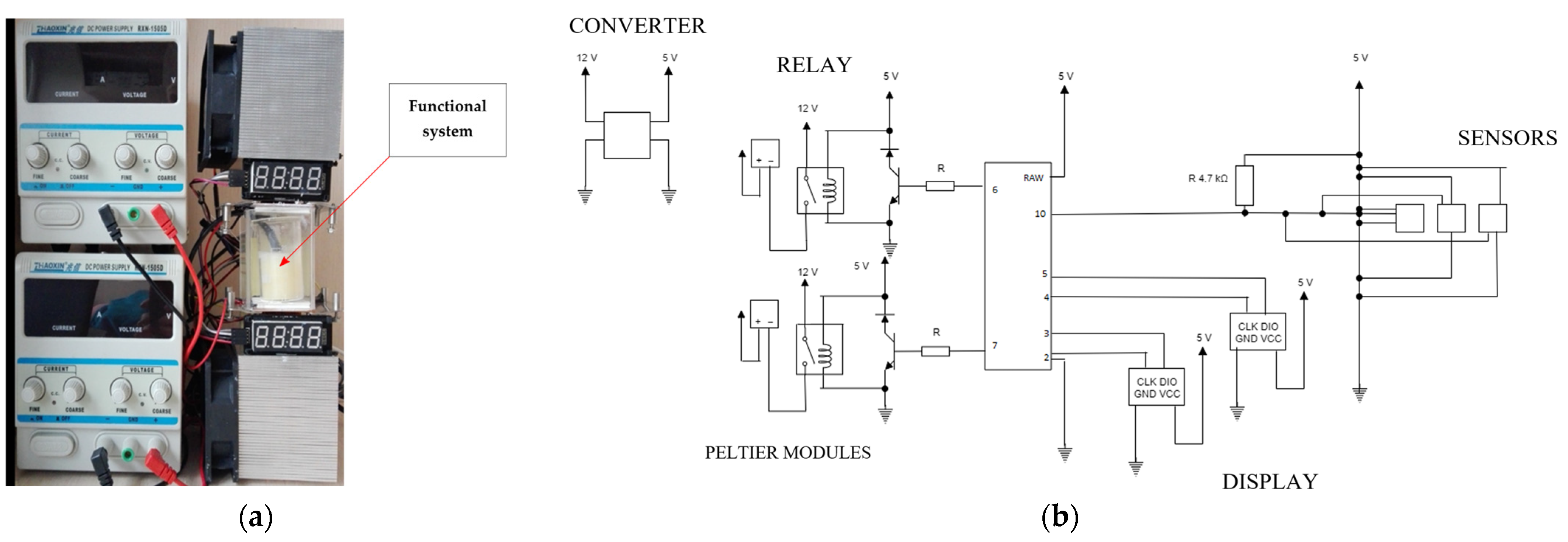
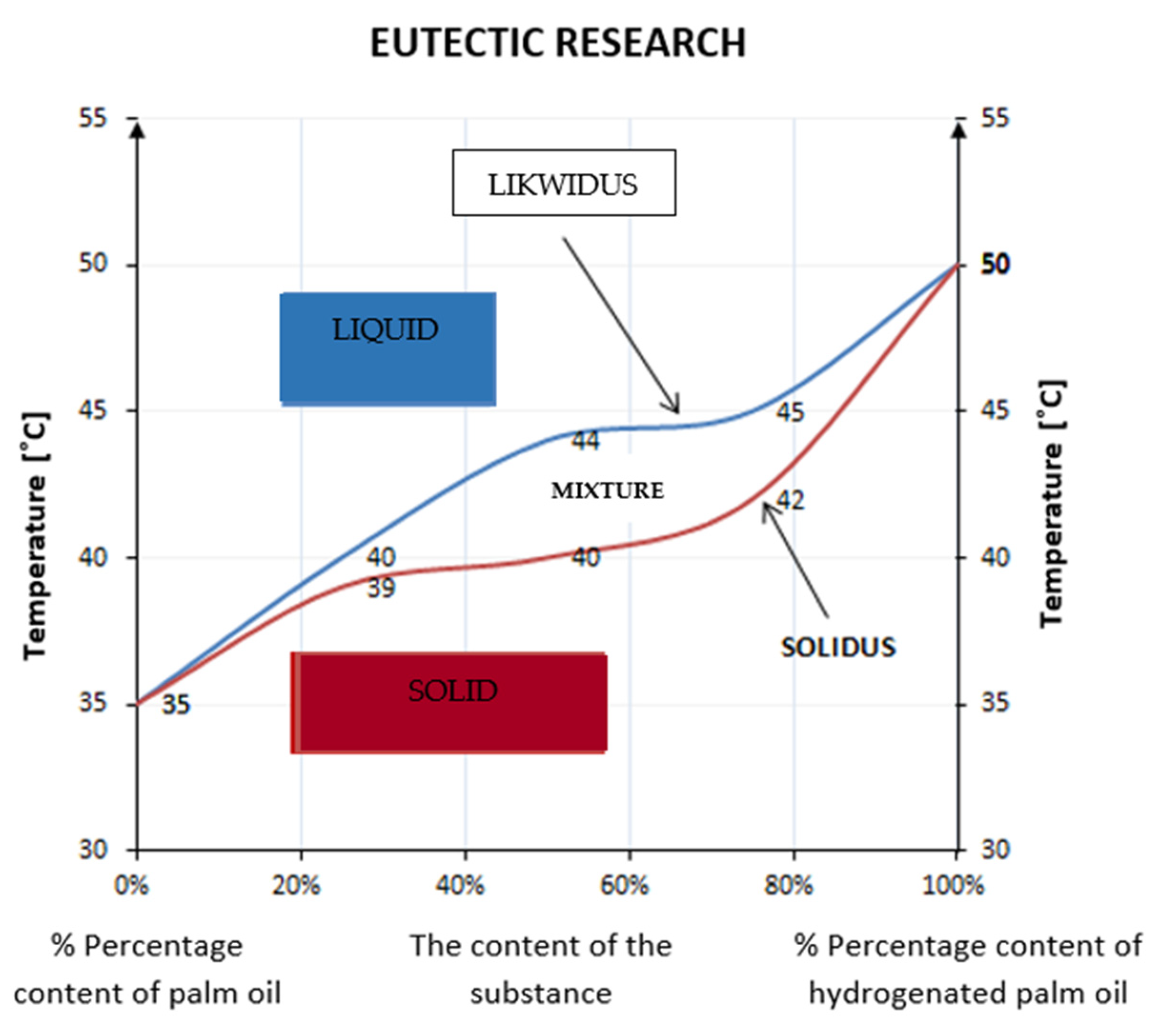
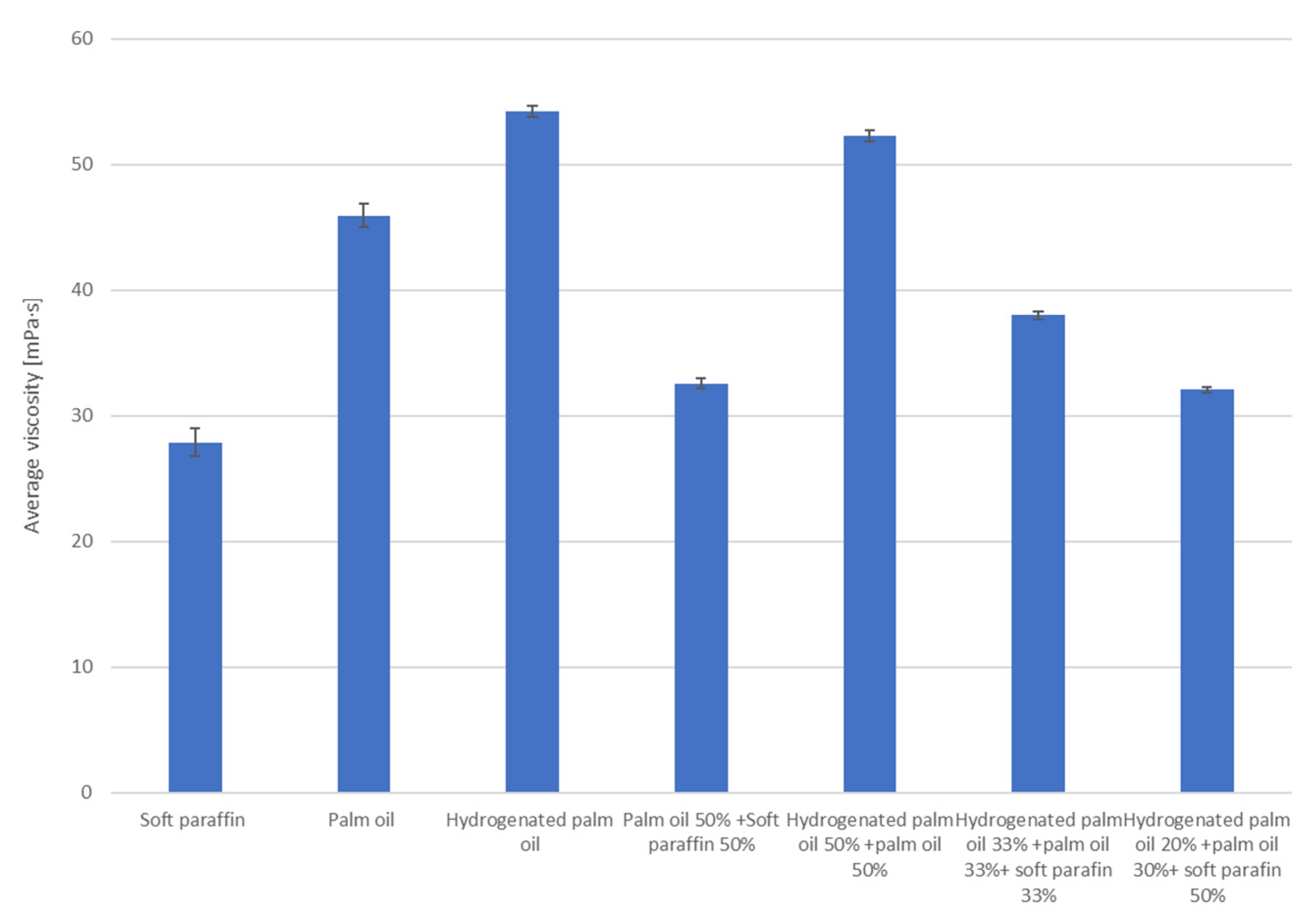
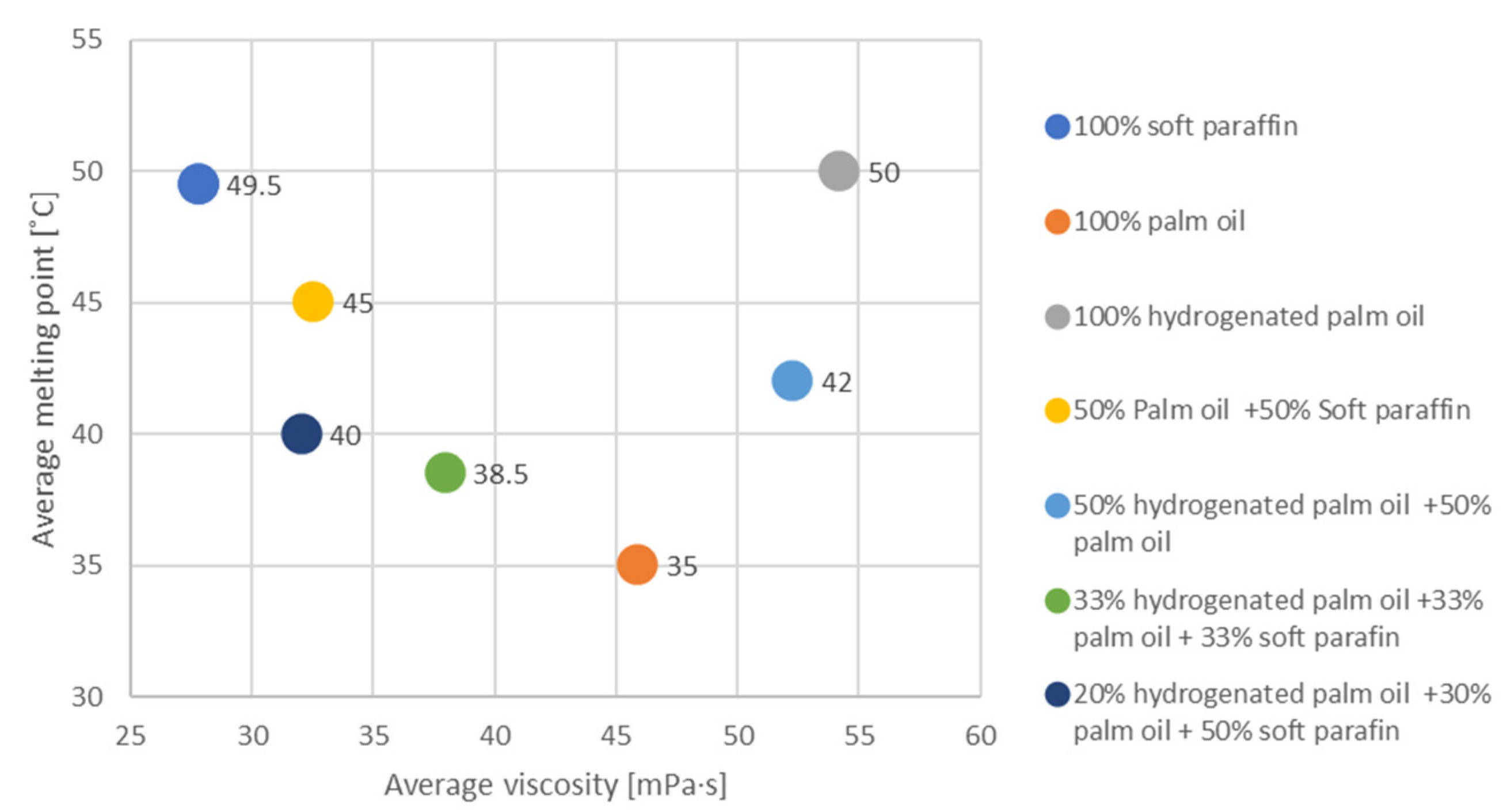
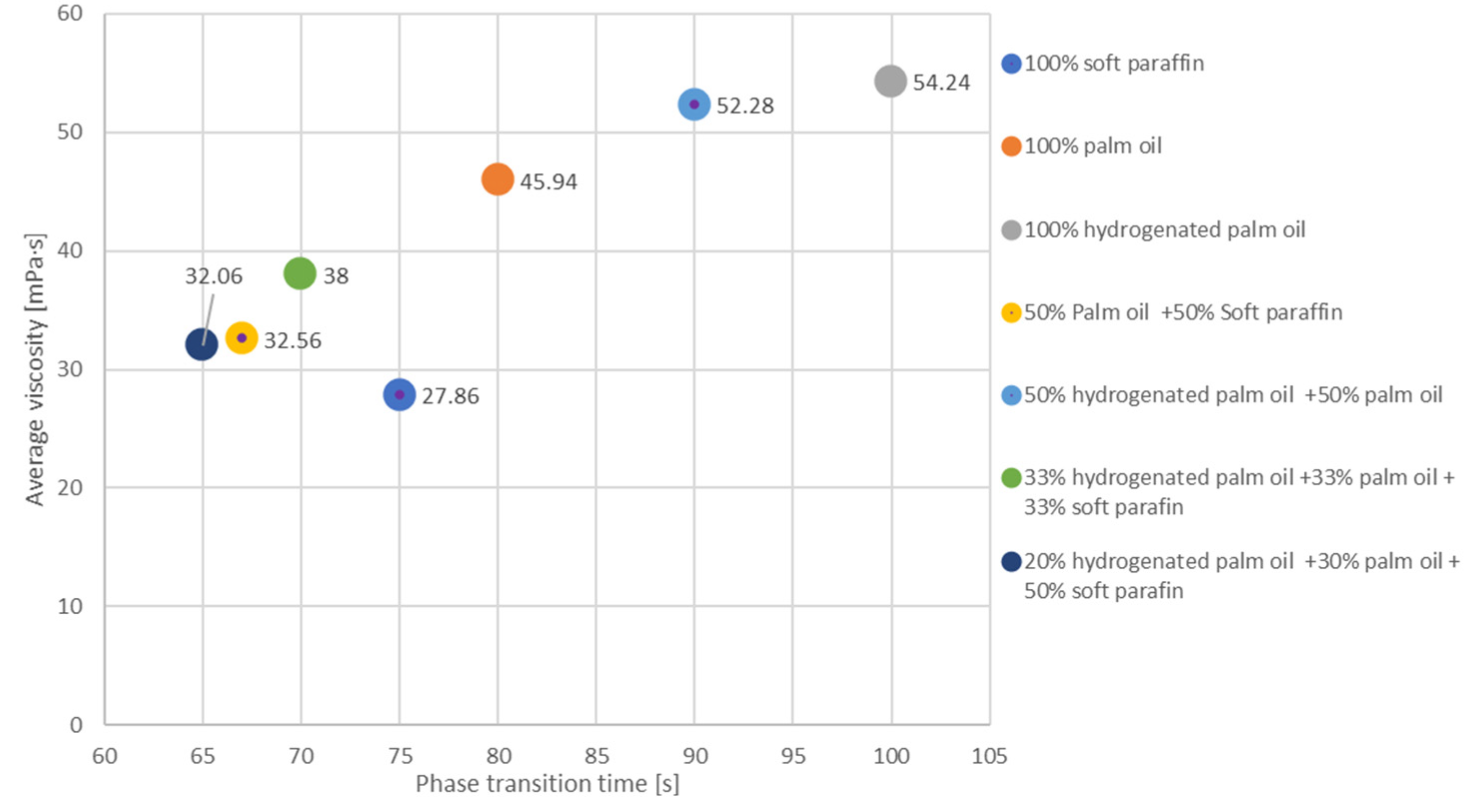
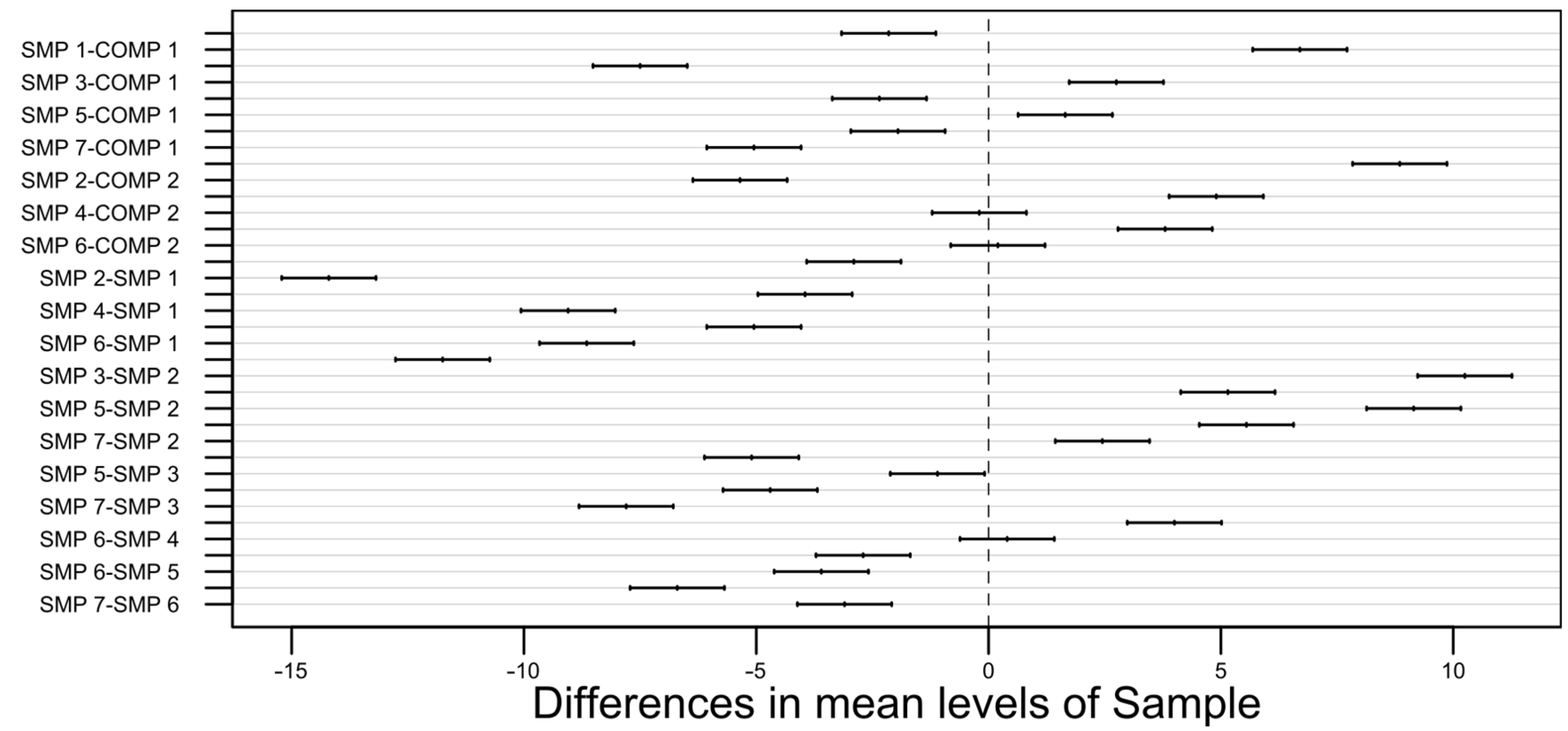
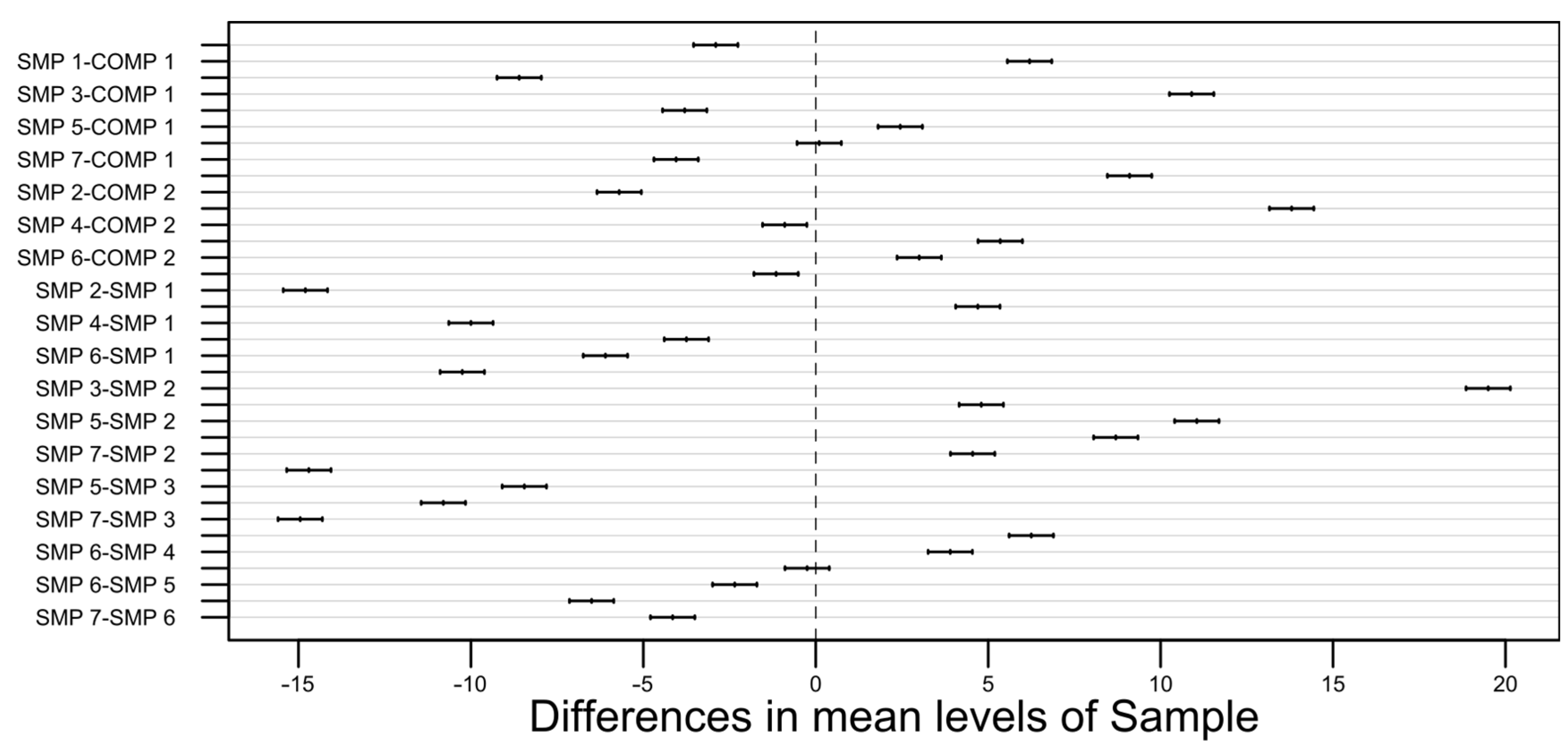

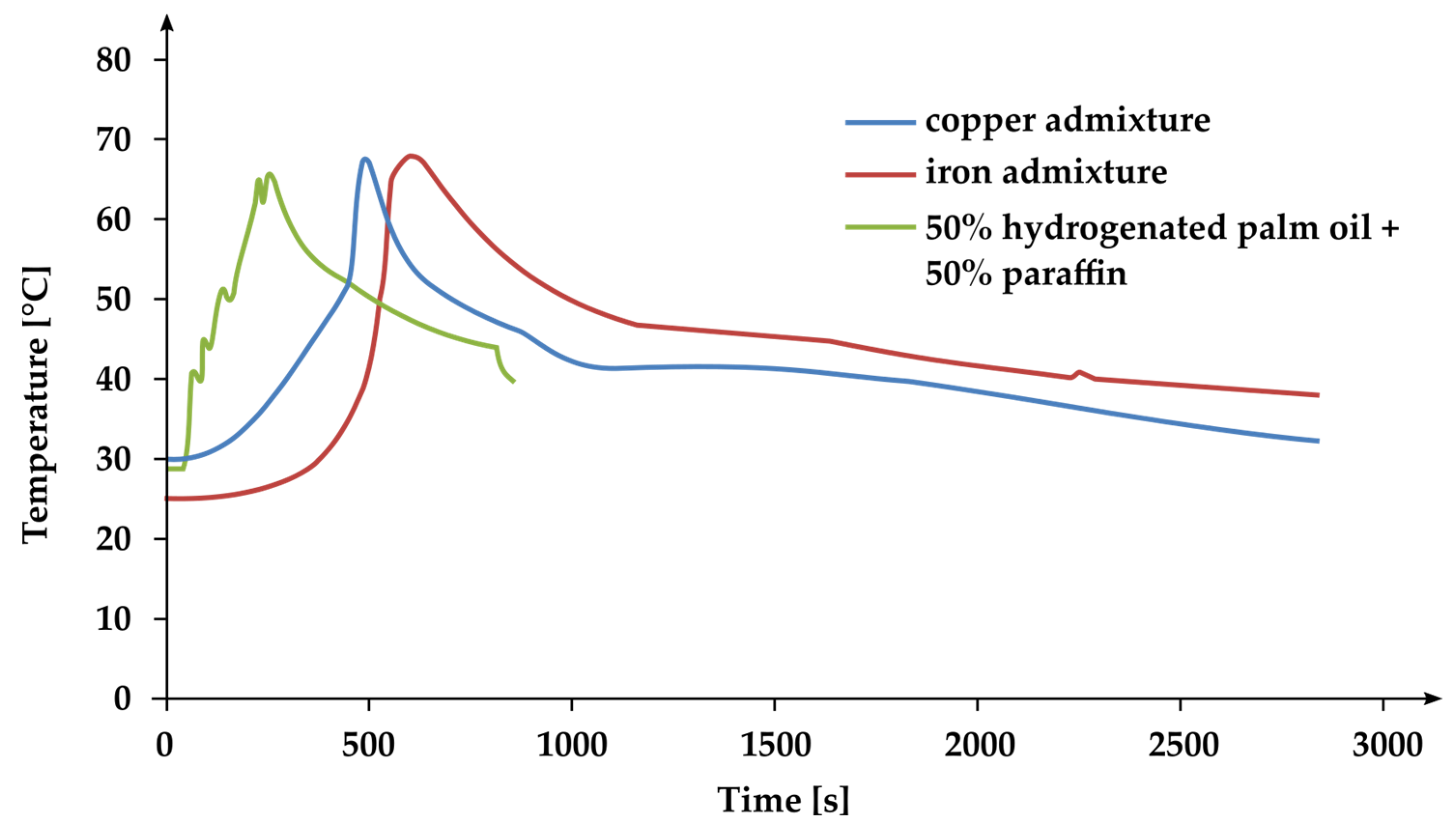
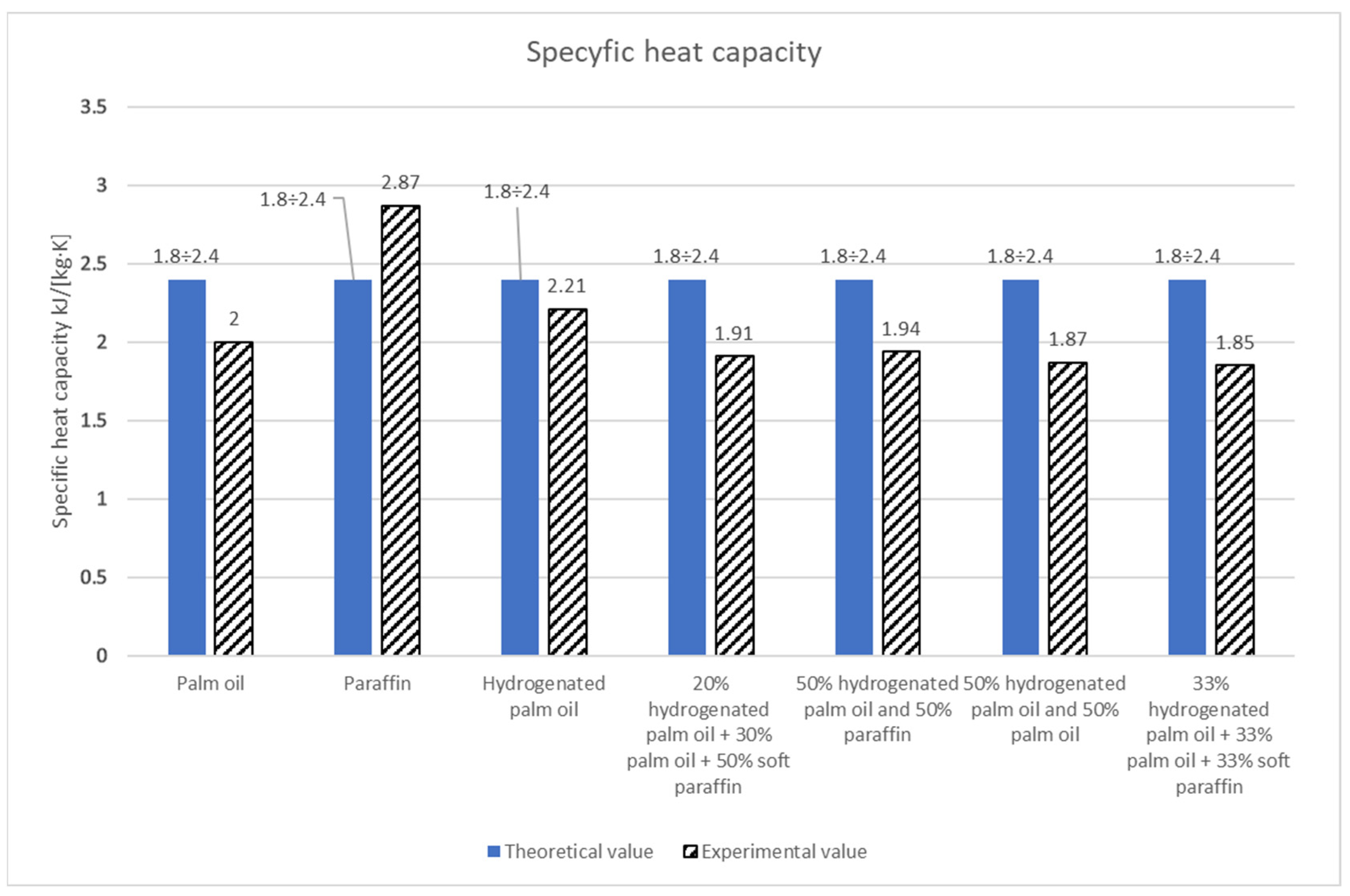

| PCM Name | Type of Material | Process | Phase Change Enthalpy [kJ/kg] | Melting Point [°C] |
|---|---|---|---|---|
| Paraffin C17 | organic | solid–liquid | 213 | 22 |
| Paraffin RT27 | organic | 179 | 28 | |
| Microencapsulated paraffin (Micronal DS 5001 X) | organic | 245 | 26 | |
| Glycerin | organic | 199 | 18 | |
| CH3(CH2)12COO(CH2)2CH3 | organic | 186 | 19 | |
| CH3(CH2)11OH | organic | 189 | 16–23 | |
| Na2HPO412H2O | inorganic | 265 | 35 | |
| Na2CO310H2O | inorganic | 247 | 34 | |
| LiNO3·3H2O | inorganic | 196 | 30 | |
| Mn(NO3)2·6H2O | inorganic | 126 | 26 |
| Name | Value |
|---|---|
| Color | White/Yellow |
| Water content | ≤0.1 wt.% |
| Melting temperature | 33–39 °C |
| Density | 0.9 [g/cm3] (at 50 °C) |
| Viscosity | 35 [mPa·s] |
| Boiling point | ≥350 °C |
| Name | Value |
|---|---|
| Color | Yellow |
| Water content | ≤0.1 wt.% |
| Melting temperature | 55–58 °C |
| Density | 0.92–0.98 [g/cm3] (at 20 °C) |
| Viscosity | 50 [mPa·s] |
| Boiling point | ≥400 °C |
| Name | Value |
|---|---|
| Color | White |
| Water content | ≤0.1 wt.% |
| Melting temperature | 45–50 °C |
| Density | 0.755 [g/cm3] (at 100 °C) |
| Viscosity | 49.5 [mPa·s] |
| Boiling point | ≥300 °C |
| Number | Palm Oil [wt.%] | Hydrogenated Palm Oil [wt.%] | Soft Paraffin [wt.%] | Additional Material |
|---|---|---|---|---|
| Sample 1 | — | — | 100 | — |
| Sample 2 | 100 | — | — | — |
| Sample 3 | — | 100 | — | — |
| Sample 4 | 30 | 20 | 50 | — |
| Sample 5 | — | 50 | 50 | — |
| Sample 6 | 50 | 50 | — | — |
| Sample 7 | 33 | 34 | 33 | — |
| Mixture 1 | 50 | 50 | — | Copper fines |
| Mixture 2 | 50 | 50 | — | Iron fines |
| Name | Transition Temperature [°C] | Phase Transition Time [s] | Process Time [s] |
|---|---|---|---|
| 100% paraffin | 49–50 | 75 | 800 |
| 100% palm oil | 35 | 80 | 1200 |
| 100% hydrogenated palm oil | 45–55 | 100 | 800 |
| 20% hydrogenated palm oil + 30% palm oil + 50% soft paraffin | 40 | 68 | 1000 |
| 50% hydrogenated palm oil + 50% paraffin | 44–46 | 80 | 1400 |
| 50% hydrogenated palm oil + 50% palm oil | 40–44 | 90 | 850 |
| 33% hydrogenated palm oil + 33% palm oil + 33% soft paraffin sample | 37–40 | 70 | 1200 |
| 50% hydrogenated palm oil + 50% paraffin + copper | 42–44 | no border | 2500 |
| 50% hydrogenated palm oil + 50% paraffin + iron | 40–41 | no border | 2700 |
| Category | DOFs | SS | MSS | F-Value | p-Value |
|---|---|---|---|---|---|
| Response for minimum transition temperature | |||||
| Sample Type | 8 | 2832.1 | 354.01 | 393.89 | <2.2 × 10−16 |
| Residuals | 81 | 72.8 | 0.90 | — | — |
| Response for maximum transition temperature | |||||
| Sample Type | 8 | 2764.65 | 345.58 | 2337.5 | <2.2 × 10−16 |
| Residuals | 81 | 11.97 | 0.15 | — | — |
| Response for phase transition time | |||||
| Sample Type | 8 | 112,387 | 14,048.4 | 2951 | <2.2 × 10−16 |
| Residuals | 81 | 386 | 4.8 | — | — |
| Substance | Theoretical Heat of Fusion [kJ/kg] | Theoretical Specific Heat Capacity | Heat of Fusion [kJ/kg] | Specific Heat Capacity | Dynamic Viscosity [mPa·s] |
|---|---|---|---|---|---|
| 100% paraffin | 130–210 | 1.8–2.4 | 109.95 | 2.87 | 27.9 |
| 100% palm oil | 117.28 | 2 | 45.9 | ||
| 100% hydrogenated palm oil | 146.6 | 2.21 | 54.2 | ||
| 20% hydrogenated palm oil + 30% palm oil + 50% soft paraffin | 99.7 | 1.91 | 32 | ||
| 50% hydrogenated palm oil + 50% paraffin | 117.28 | 1.94 | 32.56 | ||
| 50% hydrogenated palm oil + 50% palm oil | 131.94 | 1.87 | 52.28 | ||
| 33% hydrogenated palm oil + 33% palm oil + 33% soft paraffin | 102.62 | 1.85 | 38 |
Disclaimer/Publisher’s Note: The statements, opinions and data contained in all publications are solely those of the individual author(s) and contributor(s) and not of MDPI and/or the editor(s). MDPI and/or the editor(s) disclaim responsibility for any injury to people or property resulting from any ideas, methods, instructions or products referred to in the content. |
© 2024 by the authors. Licensee MDPI, Basel, Switzerland. This article is an open access article distributed under the terms and conditions of the Creative Commons Attribution (CC BY) license (https://creativecommons.org/licenses/by/4.0/).
Share and Cite
Dzindziora, A.; Dzienniak, D.; Rokita, T.; Wojciechowski, J.; Sułowski, M.; Nurkusheva, S.; Bembenek, M. A Study of the Relationship between the Dynamic Viscosity and Thermodynamic Properties of Palm Oil, Hydrogenated Palm Oil, Paraffin, and Their Mixtures Enhanced with Copper and Iron Fines. Materials 2024, 17, 1538. https://doi.org/10.3390/ma17071538
Dzindziora A, Dzienniak D, Rokita T, Wojciechowski J, Sułowski M, Nurkusheva S, Bembenek M. A Study of the Relationship between the Dynamic Viscosity and Thermodynamic Properties of Palm Oil, Hydrogenated Palm Oil, Paraffin, and Their Mixtures Enhanced with Copper and Iron Fines. Materials. 2024; 17(7):1538. https://doi.org/10.3390/ma17071538
Chicago/Turabian StyleDzindziora, Agnieszka, Damian Dzienniak, Tomasz Rokita, Jerzy Wojciechowski, Maciej Sułowski, Saltanat Nurkusheva, and Michał Bembenek. 2024. "A Study of the Relationship between the Dynamic Viscosity and Thermodynamic Properties of Palm Oil, Hydrogenated Palm Oil, Paraffin, and Their Mixtures Enhanced with Copper and Iron Fines" Materials 17, no. 7: 1538. https://doi.org/10.3390/ma17071538






